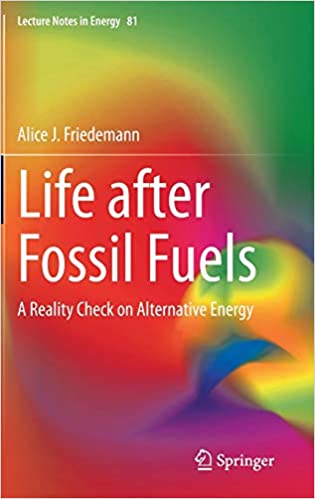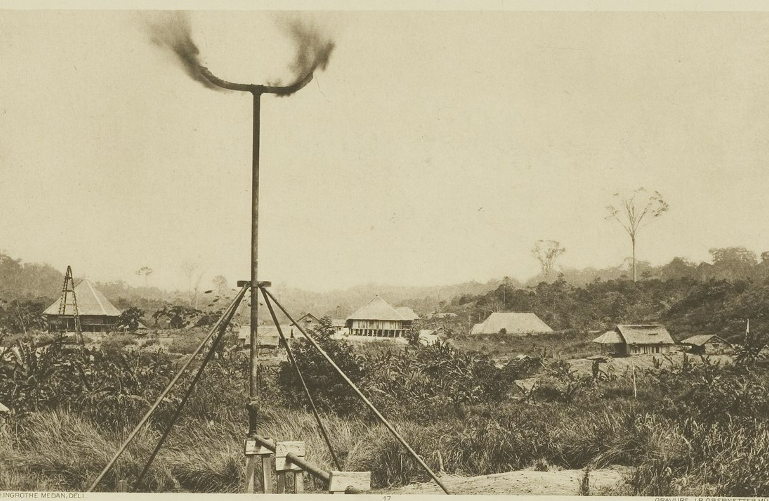 Life After Fossil Fuels: A Reality Check on Alternative Energy
Life After Fossil Fuels: A Reality Check on Alternative Energy
(Lecture Notes in Energy, Volume 81)
By Alice J. Friedemann
207 pp., hardcover. Springer International Publishing – Mar. 2021. $149.99.
Fossil fuels are the lifeblood of modern industrial society, and they’re steadily being depleted. Eventually, their rates of production will cease to grow and will begin to permanently decline, spelling disaster for a civilization dependent on ever-increasing quantities of ever-cheaper fossil energy. Their supposed replacements are pitiably inadequate, possessing nowhere near the necessary abundance, concentration, versatility, transportability and/or commercial viability. Given how long it takes to build an entirely new energy infrastructure, the time to begin doing so was decades ago. Since we didn’t do that, we now face not a continuation of our present lifestyles courtesy of alternative energy sources, but an involuntary “simplification” of every aspect of our lives, to quote energy researcher and author Alice Friedemann.
While many of the above facts are well known among those who follow the subject of fossil fuel depletion, they aren’t often presented as accessibly or concisely as in Friedemann’s book Life After Fossil Fuels. Friedemann excels at distilling the intricacies of our energy situation down into short, easily digestible chapters. Her writing is relaxed and witty, and she makes fine use of graphs, figures and future scenarios to illustrate her points. Her policy prescriptions are both eminently sensible and anathema to today’s mainstream sensibilities. (It’s difficult to imagine, for instance, a politician or pundit proposing the replacement of tractors with horses, no matter how great the benefit to fuel conservation efforts and the health of soils.) In short, herein lies a powerhouse of deftly conveyed information and insight into our current historical moment with regard to energy.
Friedemann’s analysis starts with the most concentrated and widely used fossil fuel, petroleum (aka oil). She succinctly chronicles the evolution of the oil industry, from that first big gusher in Spindletop, Texas, in 1901 to the money-losing proposition that is the present-day U.S. tight oil (i.e., shale oil) industry. She goes on to reveal the profound degree to which oil has enmeshed itself into every part of our lives, having become the lynchpin of cement and steel production, road construction, automobile manufacturing, agriculture, healthcare and innumerable other things. And she wonderfully conveys a sense of the sheer energy density of conventional oil, along with the implications of its 2005 production peak, steadily shrinking energy return on investment (EROI) ratio and present decline rate.
The book’s appraisal of alternative energy sources is comprehensive. It begins by considering potential replacements for diesel fuel in commercial freight transport. Options examined include liquefied coal, liquefied natural gas, hydrogen, power-to-gas (P2G) and biodiesel—only the latter of which meets the requirement of being both renewable and commercial. Friedemann refers to biodiesel as “the great hope, our main hope, to replace diesel for transportation and fossils in manufacturing.” Unfortunately, it has serious shortcomings, including its poor EROI and inability to travel in pipelines or serve as a drop-in replacement for conventional diesel. Thus, it’s anything but a true “alternative” to the latter.
Friedemann also enumerates the many failings of a host of proposed schemes for running manufacturing, electricity generation, public transit, agriculture and other critical sectors on alternatives. We learn that battery-powered commercial transport is a nonstarter because the batteries’ energy density is too low and their cost, weight and charging time far too great. As for the use of overhead electric catenary wires to power commercial trucks, this is still in its infancy and would be extremely costly to implement. Using electricity or renewables to fuel manufacturing would be impracticable because manufacturing processes require high temperatures that can be generated only through onsite furnaces, kilns and boilers fueled by either fossil fuels or wood. Nor is there a clear path toward transitioning the electrical grid to renewables.
The author does a superb job of uncovering some of the dodgy tactics used by alternative energy shills in their attempts to make their preferred energy options look more promising than they are. For example, she shows how proponents of ethanol and algal biodiesel employ statistical sleight of hand—namely, counting the energy contained in these fuels’ byproducts toward their EROIs—to conceal the marginal or negative energy returns from which both suffer. Another dishonest tactic is the use of questionable definitions. The U.S. Energy Information administration (EIA) committed this latter offense when, a few years back, it inflated production figures for cellulosic ethanol by broadening that fuel’s definition to include methane emanating from manure and landfills. Quips Friedemann, “[T]hat is manure. Literally trash talk!”
We are, in Friedemann’s view, fated to revert to what she calls a Wood World, or one fueled by and constructed of wood and other forms of biomass. Friedemann meticulously details how, of all the purported alternatives, only biomass is able to perform several of the crucial civilization services currently carried out by oil. It’s the only one capable of powering locomotives, heavy-duty trucks and ships. It’s the only one that can generate the high heat needed for manufacturing, or, in conjunction with hydropower, keep the electric grid going. It’s also the only viable feedstock candidate for plastic or the hundreds of thousands of other products now made from oil. And composted biomass is the only known replacement for fossil fuel-based fertilizers.
There are some catches, however. Wood is only a fraction as energy-dense as fossil fuels, meaning that while it’s capable of fueling transportation, manufacturing and other essential services, prodigious quantities of it would be required for us to continue doing these things at their current levels. Also, unlike fossil fuels, which are conveniently concentrated into deposits, trees are dispersed across the landscape. In a world of wood-fueled transport, it will no longer make sense to harvest trees from distant lands, as the energy required to get back home would consume the entire payload. Trees are also slow to regenerate, so wooded areas will be at continual risk of deforestation by those communities that do happen to be in close enough proximity to exploit them.
Our transition to wood and other forms of biomass will have serious implications for the climate, warns Friedemann. This is because of the essential role that plant life plays in sequestering carbon and regulating climate, along with the fact that its combustion has been shown to produce even more carbon dioxide than that of coal. Friedemann’s chief prescription for mitigating the increased strain on the climate system is a concerted movement to reduce the human population. Since fewer people translates to lower greenhouse gas emissions and less pressure on the plants that soak up these emissions, Friedemann reasons that climate change could be greatly ameliorated by a worldwide effort toward family planning. (She stresses, however, that the population is set to decline no matter what we do, owing to the inevitable dissolution of the industrial agricultural system that makes today’s human numbers possible.)
It’s sobering to reflect on how many fixtures of early 21st-century life we stand to lose as fossil fuels wane. Because of the difficulty, in these fuels’ absence, of generating the heat needed to smelt metals and make bricks, glass and ceramics, Friedemann predicts our infrastructure will be made mostly of wood in the future. Needless to say, she doesn’t expect we’ll be making computer chips indefinitely, as their metal alloys require especially high heat. Moreover, high tech in general relies on a slew of rare earth metals that could be running short by mid-century. Another reason why computer chips, glass and ceramics—not to mention concrete, asphalt pavement, paint and abrasives—may vanish is the depletion of beach sand, which may be completely gone by 2100. The age of plastic, one of the most ubiquitous synthetic materials on Earth, likely also will end. Friedemann explains that while there are ways of making it from biomass, these face crippling problems of scale and complexity.
Returning to Wood World doesn’t have to mean the loss of all our modern-day innovations. Friedemann believes a number of industrial-age technologies will continue to be feasible and beneficial in a fossil fuel-constrained world, two prime examples being heat pumps used for indoor climate control and incinerators repurposed to safely dispose of plastic waste (and in the process generate heat and electricity).
But Friedemann rightly insists that certain technologies of our time, such as neurotoxic insecticides and nuclear weapons and power generation plants, must be killed and buried as soon as possible due to their immense harm potential.
Those seeking concrete steps that can be taken to ease the pain of our return to Wood World will find a wealth of suggestions for individuals, the American government and society at large. Individuals can gain practical insights into the rigors of life during crisis periods by reading memoirs and other written accounts by those who have lived through such times. The American government can begin subsidizing organic farming and erosion control; reduce waste and pollution by outlawing planned obsolescence; and repeal the renewable fuel standard that is destroying American soils by propping up “the vampire ethanol industry.” Society at large can shift its views on birth control and abortion in the interest of cushioning the coming decline in the human population.
My sole quibble with Life After Fossil Fuels is that it neglects to mention a crucial economic concept known as Jevons paradox. This is the observation that ever-greater efficiency in our use of a given resource causes us to use more of it, not less. At a time when much effort is being directed toward achieving greater and greater efficiency gains, Jevons paradox is obviously a vital reality check. Thus, its omission here is surprising.
But this oversight truly is an anomaly, with the book overall managing to do immense justice to a topic of enormous breadth and complexity. To read this book is to apprehend the depth of our fossil fuel dependence and the gravity of the challenge confronting us as the era of easily accessible fossil fuels enters its waning days.
Teaser photo credit: By Kleingrothe, C.J. (Kleingrothe, Carl Josef, 1864-1925) / Medan – Leiden University Library, KITLV, image 26871 Collection page Southeast Asian & Caribbean Images (KITLV), Public Domain, https://commons.wikimedia.org/w/index.php?curid=48356904






